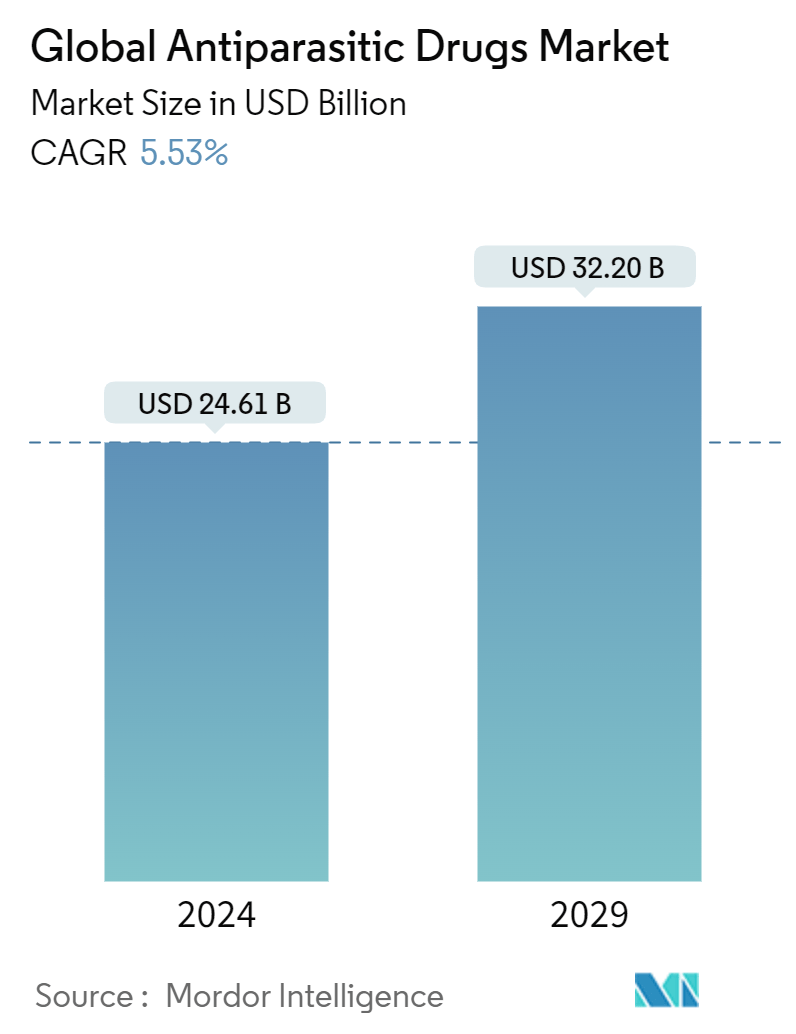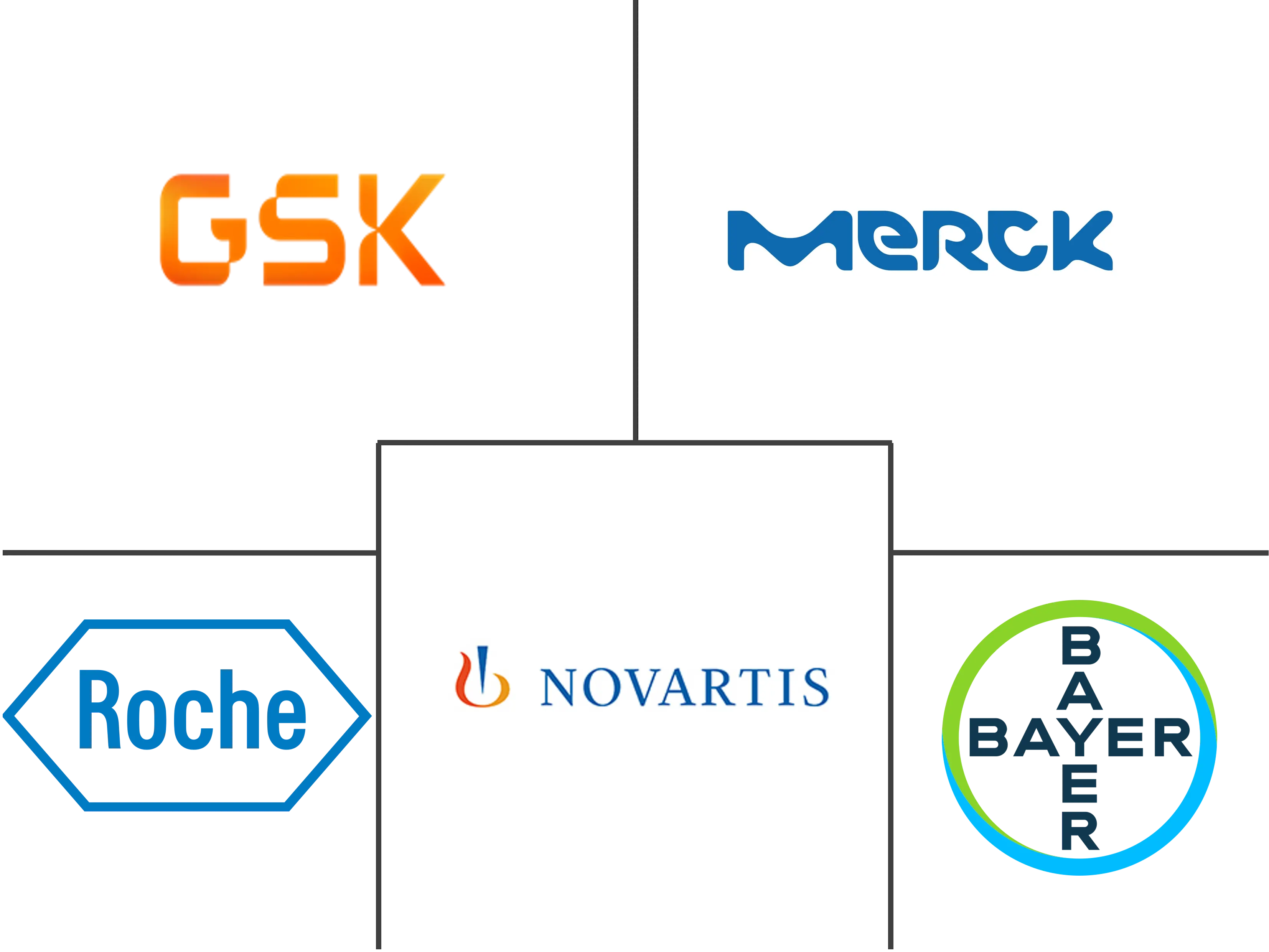Market Size of Global Antiparasitic Drugs Industry

| Study Period | 2019 - 2029 |
| Market Size (2024) | USD 24.61 Billion |
| Market Size (2029) | USD 32.20 Billion |
| CAGR (2024 - 2029) | 5.53 % |
| Fastest Growing Market | Asia-Pacific |
| Largest Market | North America |
| Market Concentration | Low |
Major Players
*Disclaimer: Major Players sorted in no particular order |
Antiparasitic Drugs Market Analysis
The Global Antiparasitic Drugs Market size is estimated at USD 24.61 billion in 2024, and is expected to reach USD 32.20 billion by 2029, growing at a CAGR of 5.53% during the forecast period (2024-2029).
The antiparasitic drugs market is a crucial pharmaceutical industry segment, primarily focused on medications that treat infections caused by parasites such as worms, protozoa, and ectoparasites. The significant factors contributing to the growth of the antiparasitic drugs market include the increasing prevalence of parasitic infections, the surge in research and development activities of companies to launch antiparasitic drugs, and the initiatives taken by the government and non-profit groups to raise public awareness regarding parasitic infections and provide appropriate treatment.
For instance, according to the World Health Organization (WHO) updates from April 2024, globally, an estimated 6–7 million individuals, predominantly in Latin America, are infected with Trypanosoma cruzi, the parasite responsible for Chagas disease. While Chagas disease is gaining a more prominent global presence, it remains primarily concentrated in 21 endemic countries across continental Latin America. In addition, as per the same source, about 75 million individuals are identified as being at risk of Trypanosoma cruzi infection. This shows the significant high parasitic disease burden, which is expected to boost market growth over the study period.
In addition, the positive recommendations of the regulators for new antiparasitic drugs are expected to increase the usage of these products in the market. For instance, in February 2024, the European Medicines Agency (EMA) issued a favorable opinion for Fexinidazole Winthrop, marking it as one of the oral treatments for rhodesiense sleeping sickness caused by Trypanosoma brucei rhodesiense. These positive opinions may increase the demand for treating parasitic infections, boosting market growth over the forecast period.
However, the adverse effects and risks associated with antiparasitic drugs are expected to hamper the growth of the antiparasitic drugs market over the forecast period.
Antiparasitic Drugs Industry Segmentation
As per the scope of the report, antiparasitic drugs are used to treat various parasitic diseases, such as those caused by parasitic fungi, protozoa, helminths, ectoparasites, and amoeba. These drugs target and attack the parasitic agents of various infections and destroy or restrain their growth and development.
The antiparasitic drugs market is segmented by drug type, route of administration, distribution channel, and geography. By drug type, the market is segmented into anthelmintics, antiprotozoals, and other drug types. By route of administration, the market is segmented into oral, injectable, and topical. By distribution channel, the market is segmented into hospital pharmacy, retail pharmacy, and other distribution channels. By geography, the market is segmented into North America, Europe, Asia-Pacific, Middle East and Africa, and South America. The market report also covers the estimated market sizes and trends for 17 countries across major regions globally. The report offers market sizes and forecasts in terms of value (USD) for the above segments.
| By Drug Type | |
| Anthelmintics | |
| Antiprotozoals | |
| Other Drug Types |
| By Route of Administration | |
| Oral | |
| Injectable | |
| Topical |
| By Distribution Channel | |
| Hospital Pharmacy | |
| Retail Pharmacy | |
| Other Distribution Channels |
| Geography | ||||||||
| ||||||||
| ||||||||
| ||||||||
| ||||||||
|
Global Antiparasitic Drugs Market Size Summary
The antiparasitic drugs market is experiencing a dynamic phase, influenced by various factors including the COVID-19 pandemic, which initially disrupted supply chains and production but later spurred interest in the antiviral properties of these drugs. The market is expected to expand steadily, driven by the rising prevalence of parasitic infections such as malaria and Chagas Disease, alongside increased research and development activities. The demand for antiparasitic drugs has been bolstered by their potential application in treating COVID-19, with drugs like Ivermectin gaining attention for their antiviral properties. Collaborative efforts among pharmaceutical companies and research institutions are fostering the development of new drug candidates, further propelling market growth. However, challenges such as adverse effects, drug resistance, and limited awareness in certain regions may impede progress.
North America is anticipated to hold a significant share of the antiparasitic drugs market, supported by the increasing prevalence of parasitic infections and strategic initiatives by key players. The region's market growth is also fueled by heightened research and development activities and the migration of populations from endemic areas. Globally, major pharmaceutical companies are leading the market, leveraging their research capabilities and distribution networks to maintain a competitive edge. The development of new antimalarial drugs and combination therapies is expected to address the challenges posed by drug resistance, particularly in malaria-endemic regions. As the market evolves, the focus on innovative solutions and strategic collaborations will be crucial in meeting the growing demand for effective antiparasitic treatments.
Global Antiparasitic Drugs Market Size - Table of Contents
-
1. MARKET DYNAMICS
-
1.1 Market Overview
-
1.2 Market Drivers
-
1.2.1 Increasing Prevalence of Parasitic Infections
-
1.2.2 Increasing Investment in Research and Development Activities
-
-
1.3 Market Restraints
-
1.3.1 Adverse Effects and Risks Associated with the Drugs
-
-
1.4 Porter's Five Forces Analysis
-
1.4.1 Threat of New Entrants
-
1.4.2 Bargaining Power of Buyers/Consumers
-
1.4.3 Bargaining Power of Suppliers
-
1.4.4 Threat of Substitute Products
-
1.4.5 Intensity of Competitive Rivalry
-
-
-
2. MARKET SEGMENTATION (Market Size by Value - in USD)
-
2.1 By Drug Type
-
2.1.1 Anthelmintics
-
2.1.2 Antiprotozoals
-
2.1.3 Other Drug Types
-
-
2.2 By Route of Administration
-
2.2.1 Oral
-
2.2.2 Injectable
-
2.2.3 Topical
-
-
2.3 By Distribution Channel
-
2.3.1 Hospital Pharmacy
-
2.3.2 Retail Pharmacy
-
2.3.3 Other Distribution Channels
-
-
2.4 Geography
-
2.4.1 North America
-
2.4.1.1 United States
-
2.4.1.2 Canada
-
2.4.1.3 Mexico
-
-
2.4.2 Europe
-
2.4.2.1 Germany
-
2.4.2.2 United Kingdom
-
2.4.2.3 France
-
2.4.2.4 Italy
-
2.4.2.5 Spain
-
2.4.2.6 Rest of Europe
-
-
2.4.3 Asia-Pacific
-
2.4.3.1 China
-
2.4.3.2 Japan
-
2.4.3.3 India
-
2.4.3.4 Australia
-
2.4.3.5 South Korea
-
2.4.3.6 Rest of Asia-Pacific
-
-
2.4.4 Middle East and Africa
-
2.4.4.1 GCC
-
2.4.4.2 South Africa
-
2.4.4.3 Rest of Middle East and Africa
-
-
2.4.5 South America
-
2.4.5.1 Brazil
-
2.4.5.2 Argentina
-
2.4.5.3 Rest of South America
-
-
-
Global Antiparasitic Drugs Market Size FAQs
How big is the Global Antiparasitic Drugs Market?
The Global Antiparasitic Drugs Market size is expected to reach USD 24.61 billion in 2024 and grow at a CAGR of 5.53% to reach USD 32.20 billion by 2029.
What is the current Global Antiparasitic Drugs Market size?
In 2024, the Global Antiparasitic Drugs Market size is expected to reach USD 24.61 billion.

